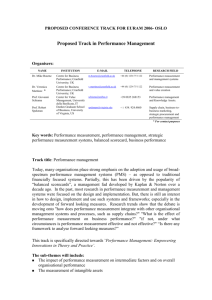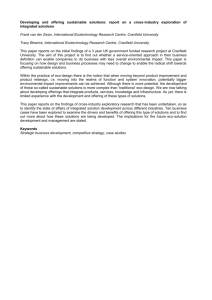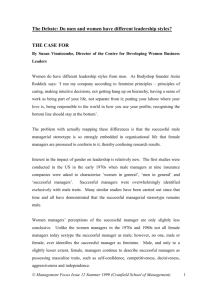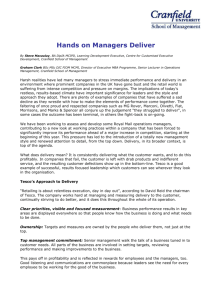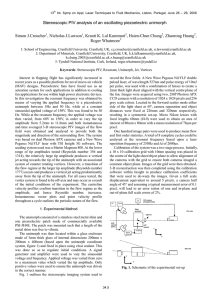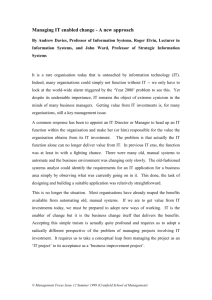Dividends of Employee Diversity - Cranfield School of Management
advertisement
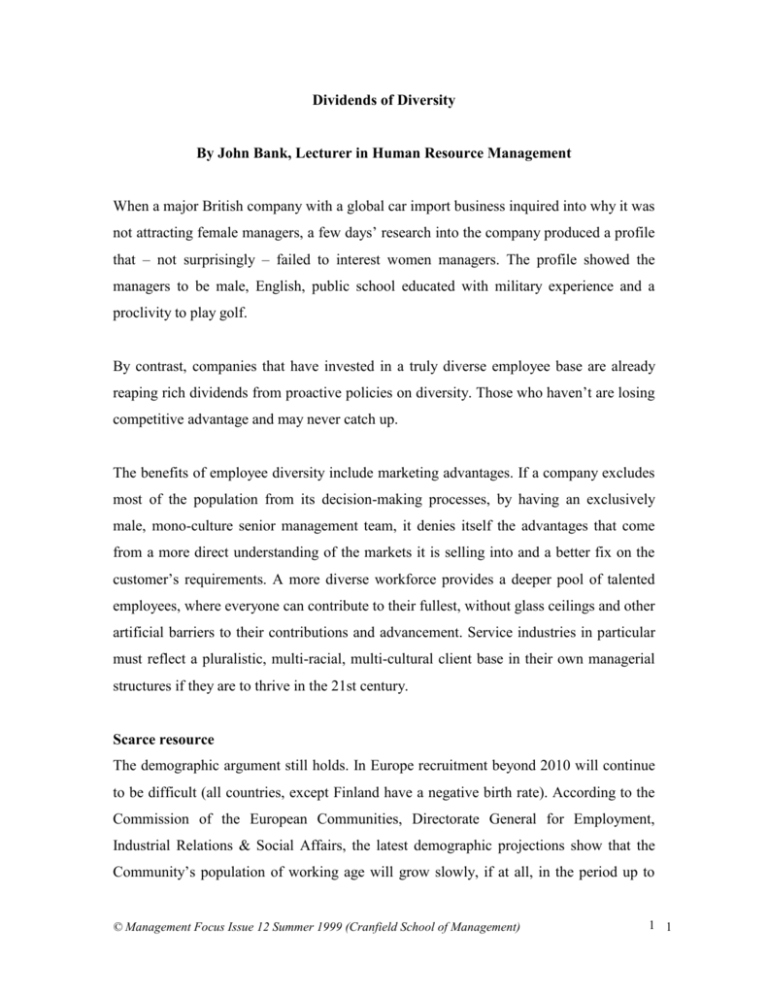
Dividends of Diversity By John Bank, Lecturer in Human Resource Management When a major British company with a global car import business inquired into why it was not attracting female managers, a few days’ research into the company produced a profile that – not surprisingly – failed to interest women managers. The profile showed the managers to be male, English, public school educated with military experience and a proclivity to play golf. By contrast, companies that have invested in a truly diverse employee base are already reaping rich dividends from proactive policies on diversity. Those who haven’t are losing competitive advantage and may never catch up. The benefits of employee diversity include marketing advantages. If a company excludes most of the population from its decision-making processes, by having an exclusively male, mono-culture senior management team, it denies itself the advantages that come from a more direct understanding of the markets it is selling into and a better fix on the customer’s requirements. A more diverse workforce provides a deeper pool of talented employees, where everyone can contribute to their fullest, without glass ceilings and other artificial barriers to their contributions and advancement. Service industries in particular must reflect a pluralistic, multi-racial, multi-cultural client base in their own managerial structures if they are to thrive in the 21st century. Scarce resource The demographic argument still holds. In Europe recruitment beyond 2010 will continue to be difficult (all countries, except Finland have a negative birth rate). According to the Commission of the European Communities, Directorate General for Employment, Industrial Relations & Social Affairs, the latest demographic projections show that the Community’s population of working age will grow slowly, if at all, in the period up to © Management Focus Issue 12 Summer 1999 (Cranfield School of Management) 1 1 2010. If there is a significant slow-down in the rate of inward migration then there is a real possibility of an absolute fall in the population of working age from this point. (This contrasts with continuous growth over the past 20 years of just under 1% a year.) As talent and skills become scarce, companies will have to cast their recruitment net wider for the skilled employees they require. They should not be surprised to find potential new recruits sceptical of their offers if they have no proven track record in employee diversity policies and practices. By contrast, companies that have a decade of development in dealing with diversity will enjoy a competitive advantage amongst recruits who can see role models from their gender, race, ethnic background, sexual orientation, physical handicap or age group already at work in the recruiting company. What is Diversity? In James Dicky’s famous film ‘Deliverance’ a group of four white, male managers from Atlanta, Georgia decide one weekend to go canoeing instead of playing golf. They drive into the Appalachian Mountains and are at first mistaken by the mountain folk for engineers from a construction company engaged in building a dam. The tension between the ‘city boys’ and the mountain folk is immediate. The managers do not recognise the values of the Appalachian culture and their arrogance is met with suspicion by the mountain people. Suspicions erupt into the full-blown hostility that provides the central conflict of the film. Diversity is simply otherness or those human qualities present in other individuals and groups that are different from our own and outside the groups to which we belong. The managers from Atlanta are too caught up in their own white middle-class values to appreciate the values of the Appalachian people and their communities. From a managerial perspective, diversity is also a value placed by the organisation on utilising contributions from a diverse workforce at all levels as a vital resource. © Management Focus Issue 12 Summer 1999 (Cranfield School of Management) 2 2 Cultural diversity By the year 2010 the American workforce will be only 45% white male. Women, Blacks, Hispanics, Immigrants will swell the labour force of USA firms. Since 1970, the number of women as a percentage of the labour force has doubled. In 1990, they made up 46% of the American workforce. How will these new employees be managed? How will companies up until now determined to stamp their corporate culture on their employees – deal with the cultural diversities these same employees bring to the work place? Dimensions of Diversity By dimensions of diversity I mean the properties and characteristics that constitute the whole person. There are primary and secondary dimensions of diversity. Primary dimensions of diversity are those immutable human differences that are inborn and/or that exert an important impact on a person’s socialisation and an impact on them throughout their lives. There are six of them: age ethnicity gender physical abilities/qualities (disabilities) race sexual/affectional orientation Gender, for instance, is critical in the UK workforce imbalance. Out of 20,000 directors of UK public companies, according to the Arthur Andersen Corporate Register, there were only 234 women directors holding between them 113 executive directorships and © Management Focus Issue 12 Summer 1999 (Cranfield School of Management) 3 3 155 non-executive posts. Age is another critical diversity dimension. A third of all men between the ages of 50 and 65 are currently unemployed. Is the future female? Women earn one-third of the MBAs according to the US Department of Education 1996 Digest of Education Statistics. In addition, virtually half of all new business, law and doctorate degrees are awarded to women. Half of all undergraduate degrees in business and management, accounting and mathematics go to women as well which helps the case that the future is female. What new management styles will women managers evolve? What will the boardroom of a truly diverse company look like? Secondary dimensions of diversity are those that can be changed – the mutable differences we acquire, discard and/or modify throughout our lives. Some examples include: educational background geographic location income levels marital status military status parental status religious beliefs work experience The ‘old boy’ network is a good example of how secondary dimensions of diversity play a major part in job allocation. An Oxbridge education can be an unspoken but necessary qualification for certain jobs in particular institutions in the City. Some city companies prefer their employees to have an army background. The novelist Anthony Burgess © Management Focus Issue 12 Summer 1999 (Cranfield School of Management) 4 4 always maintained that coming from catholic schools in Manchester and Manchester University made his career as a novelist doubly difficult as most British novelists, critics and publishers were all friends and colleagues from Oxford University. Being married is an expectation for most male senior managers in business, whereas for a woman it can seriously limit her rise to senior management in certain companies. To become a truly global player in today's global market a company's top team simply cannot remain mono-cultural and be effective. At the centre of the strategy to downsize, driven by recession and increased global competition, is the requirement for a company to have the right mix of employees in terms of gender and other dimensions of diversity. Trouble at Texaco In the difficult task of diversity there is no room for hypocrisy. In November 1996, while Texaco was hard at work rolling out an employee diversity policy in Britain that contained all the right aspirations, the transcript of a meeting between senior officials of Texaco Inc. in the US, appeared on the front page of the New York Times. According to the transcript from a hidden tape recorder, the executives openly discussed shredding minutes of meetings and other documents that were sought by black employees in order to bolster their charges that Texaco discriminates against minorities in promotion and fosters a racially hostile company culture. What is more, the tone and substance of the discussion were racially offensive. In a damage limitation exercise, with Jesse Jackson calling for a global boycott of Texaco, chairman Peter I. Bijur spent $176 million to end the lawsuits filed by black employees. It was the biggest settlement ever of a US discrimination case. The Texaco settlement (see box) if implemented whole-heartedly could transform the company to a leading-edge role model for global firms not just for American companies. © Management Focus Issue 12 Summer 1999 (Cranfield School of Management) 5 5 TEXACO’S DIVERSITY PAY OUT $115 million in cash to about 1,400 current and former Afro-American workers. $26.1 million in pay rises over five years for Afro-American employees. $45 million for diversity training. The creation of equality and tolerance task force composed of three members selected by the company, three members named by plaintiffs in the lawsuits that sparked the issue, and a chairperson agreed on by both sides to make: 1. Changes in employment policy. 2. Reports twice yearly to the Board. 3. Judgements from information available from company records. Ford falters Even companies which have a diverse workforce can get it wrong. Recently, Ford had its own negative publicity over an advertising farce that insulted its already diverse workforce in the UK. A photo was taken of employees at its Dagenham plant, which included five members of ethnic minorities. When the same photo reappeared several years later their faces had been replaced by white ones. This greatly offended all five of the people – four of whom were still working at the plant. Ford management apologised to the offended workers and gave them each a cheque for £1,500 in compensation for their hurt feelings. But not before the union at the plant staged an angry walkout over the issue that cost the company an estimated £2.8 million in lost production. The fault Ford said, lay with its advertising agency, who redid the photo for promotional use in Poland because the original photo ‘did not portray the ethnic mix in Eastern Europe’. © Management Focus Issue 12 Summer 1999 (Cranfield School of Management) 6 6 The pluralistic leader The demand for diversity, which flows from a business case as well as the ethical principles of a level playing field for all and good corporate citizenship, requires a new leadership style. The pluralistic leader: has vision and values that recognise and support diversity within the firm; demonstrates ethical commitment to fairness and the elimination of all types of workplace discrimination; possesses a broad knowledge and awareness regarding primary and secondary dimensions of diversity and multicultural issues; is open to change based on diverse inputs and feedback about his/her personal filters and blind spots; is a mentor and empowerer of diverse employees; remains an ongoing catalyst and model for individual and organisational change. Nearly 90 years after Israel Zangwill first wrote of the American ‘melting pot’, referring to the European immigration experience in the US, the myth of homogenisation is dead. Some of the best American and European companies are now creating a new rainbow workforce where diverse cultures are cultivated and managed rather than absorbed and assimilated. The ‘cookie cutter’ concept of company culture, where firms like IBM created employees in their own peculiar image, is gone forever. In its place is employee diversity where divergent and diverse contributions are welcomed. . © Management Focus Issue 12 Summer 1999 (Cranfield School of Management) 7 7 The dangers of group think The disastrous launch of the Space Shuttle challenger on January 28, 1986 is attributed, in part, to the homogeneous company culture of the decision-makers – male engineers with identical engineering backgrounds and similar personality profiles. The NASA managers were so hell-bent on reaching their objectives that they ignored safety warnings from outside contractors Rockwells (about ice on the launch pad) and from Morton Thiokol (about the cold temperature and rubber O-rings) and their own engineers who opposed the launch. Because these NASA managers were too similar in type and background (WASPS), they easily developed a “group think” mentality and a management style that let programme objectives override good judgement. Since research indicates that individuals cannot be made to change their management profile drastically in the long run, the way to change the aggregate profile of NASA managers is to bring in a small but significant number of managers from outside the agency who are not in the NASA mould and who would add the desired diversity to the team. Best Practice From July 1998 to March 1999, BT ran a ‘Freedom to Work’ initiative in its Cardiff and Swindon Software Engineering Centre (CSEC), part of the company’s Networks and Information Services Division. Delivering and supporting information technology products and services is a rapidly expanding industry where there are national skills shortages. So it is in BT’s interest to keep its employees. The ‘Freedom to Work’ pilot project allowed some of the 600 employees of CSEC -- 20% of whom are women -- to design their own working patterns © Management Focus Issue 12 Summer 1999 (Cranfield School of Management) 8 8 to achieve a better balance between work and home-life. Some 18 employees and a number of senior managers participated in the experiment. Volunteers were invited to be radical and creative in their proposals for changes in their working patterns. The changes included homeworking, working full-time but only over four days, and working a combination of long and short days. As a direct result of the scheme, three participants who say they would otherwise have left, stayed with CSEC. In another case, a male employee with two disabled children was able to design his working day so that he could share the school-run, allowing his previously unemployed wife to take on part-time translation work. Women employees participating in the scheme said they no longer felt guilty about the balancing act of work and home needs. Two maternity leavers in the scheme returned to full-time rather than part-time work. The dividends to the company in addition to retention of skilled staff (labour turnover fell to 5% compared to 15% in similar centres) included improved productivity among some participants, the attraction of new employees to the company, a cut in overtime costs, and greater customer satisfaction. The scheme was so successful, it has now been recommended to the BT board that it be integrated into mainstream company policy. Such initiatives are not only of internal benefit to the company, they win favourable publicity. Organisations such as Opportunity 2000 are quick to award best practice companies. Last year Fortune magazine (August 3, 1998) published for the first time ‘The 50 best companies for Asians, Blacks and Hispanics’ under the banner ‘companies that actually do something about diversity’. At these 50 best companies, the CEO leads the diversity mantra and he does more than merely encourage his executives to build a diverse workforce: he makes part of their bonuses depend on it. ‘What gets measured gets done,’ explained Jim Adamson, CEO of Advantico, which came second from the top of the list. Employees at these companies are encouraged to discuss and debate sensitive race issues in the workplace without fear of © Management Focus Issue 12 Summer 1999 (Cranfield School of Management) 9 9 damaging their careers. Lucent Technologies, ranked number 16, goes as far as giving financial support to groups representing Asian, Black and Hispanic workers as well as to gay, lesbian and disabled groups. These employee groups have national conventions and each has its own website. How well do these companies with proven track records in employee diversity deliver to their shareholders? ‘The average return to investors for the publicly traded companies on our list walloped the S & P 500 over the past three – and five – year periods: 125.4% to 112.2% and 200.8% to 171.2%, respectively,’ Fortune reported. ‘No one can say that companies striving for – and in most cases, investing heavily in – ethnic inclusion at every level are doing so at the expense of profits.’ Commit to the cause In the past diversity was driven by social justice considerations. These concerns for fairness are still with us today and form the basis of ethical commitment to diversity. But on these moral foundations the managers of the 21st century are challenged to begin building the business case for diversity to gain great dividends. The words of Goethe come into play in meeting the challenge and committing oneself to the cause of diversity: Whatever you can do, Or dream you can, begin it. Boldness has genius, Power and magic in it © Management Focus Issue 12 Summer 1999 (Cranfield School of Management) 10 10
